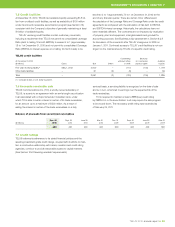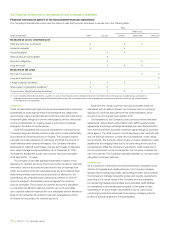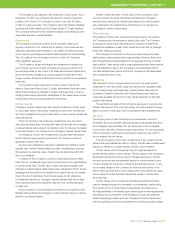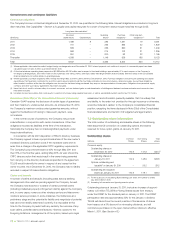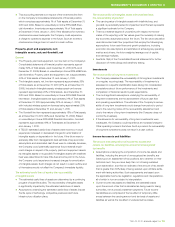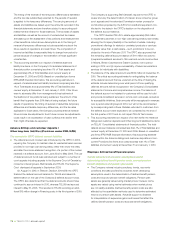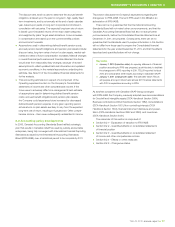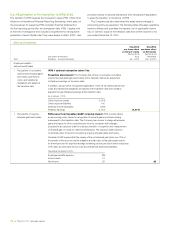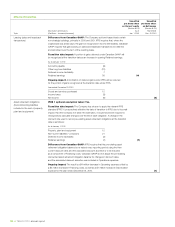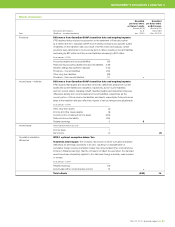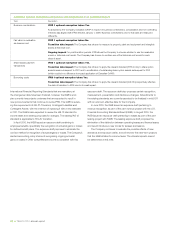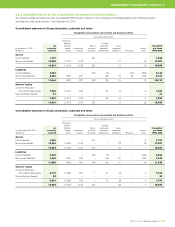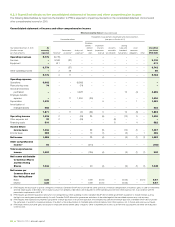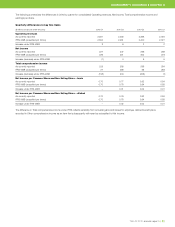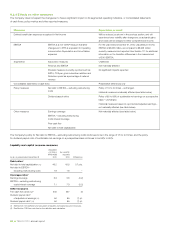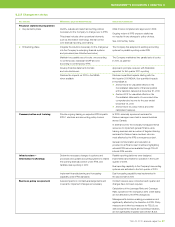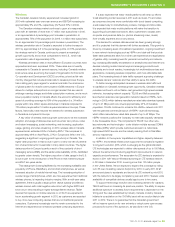Telus 2010 Annual Report Download - page 83
Download and view the complete annual report
Please find page 83 of the 2010 Telus annual report below. You can navigate through the pages in the report by either clicking on the pages listed below, or by using the keyword search tool below to find specific information within the annual report.
TELUS 2010 annual report . 79
Effects of transition
Topic
Unaudited Unaudited
pro forma effect pro forma effect
on Owners’ equity on Net income
(Section 8.2.2) (Section 8.2.3)
Description and impacts As at Year ended
($ millions – increase (decrease)) Jan. 1, 2010 Dec. 31, 2010
Impairment of assets Difference from Canadian GAAP: IFRS requires that increases in recoverable
amounts of impaired assets subsequent to the time of impairment be recognized
as an impairment reversal (except for goodwill), but only to the extent that the resulting
carrying amount would not exceed the carrying amount that would have existed had
an impairment amount not initially been recognized. Canadian GAAP did not allow
for increases in recoverable amounts of impaired assets subsequent to the time of
impairment to be recognized.
IFRS requires, given the Company’s facts and circumstances, that the Company’s
spectrum licences be assessed for impairment as a part of the Wireless cash-
generating unit. The result is that the $910 million impairment recorded by the
Company in 2002 would not have been required under IFRS. Previously, given the
Company’s facts and circumstances, the application of Canadian GAAP resulted
in the Company’s spectrum licences being assessed for impairment separately.
Transition date impact: In addition to impairment reversals, IFRS transitional
rules require the amortization cessation for intangible assets with indefinite lives to
be accounted for retrospectively with the result being the reversal of the amortization
previously recorded under Canadian GAAP. When Canadian GAAP introduced
impairment of assets for intangible assets with indefinite lives, it concurrently ceased
requiring their amortization on a prospective basis and thus $108 million of associated
amortization recorded to then by the Company was not reversed. The Company has
also recorded impairment reversals, net of accumulated depreciation of $91 million
at the transition date for certain property, plant and equipment impairments recorded
by predecessor companies.
As at January 1, 2010
Property, plant and equipment, net 91
Intangible assets, net (impairment reversal) 910
Intangible assets, net (amortization reversal) 108
Deferred income tax liability 281
Retained earnings 828 828
Ongoing impact: The transition date impairment reversal for property, plant and
equipment impairment recorded in predecessor companies results in a minor increase
in depreciation expense. Volatility in Net income could result from periodic impairment
tests, should the facts support a future impairment.
Year ended December 31, 2010
Depreciation 5
Income taxes (1)
Net income (4) (4)
Sale of accounts receivable Difference from Canadian GAAP: IFRS does not permit de-recognition of the
accounts receivable sold to an arm’s-length securitization trust, given the Company’s
facts and circumstances. IFRS considers the sale proceeds to be short-term
borrowings of the Company. Canadian GAAP de-recognized accounts receivable
sold to the arm’s-length securitization trust with which the Company transacts.
Transition date impact: Proceeds from the sale of accounts receivable under the
Company’s accounts receivable securitization agreement are recorded as short-term
borrowings, rather than a reduction of Accounts receivable (or de-recognition).
As at January 1, 2010
Accounts receivable 501
Short-term borrowings 500
Accounts payable and accrued liabilities (1)
Income and other taxes payable 1
Retained earnings 1 1
Ongoing impact: Accounts receivable securitization expenses of $8 million for the
year ended December 31, 2010, are included in Financing costs under IFRS, rather
than in Other expense under Canadian GAAP. –
MANAGEMENT’S DISCUSSION & ANALYSIS: 8


